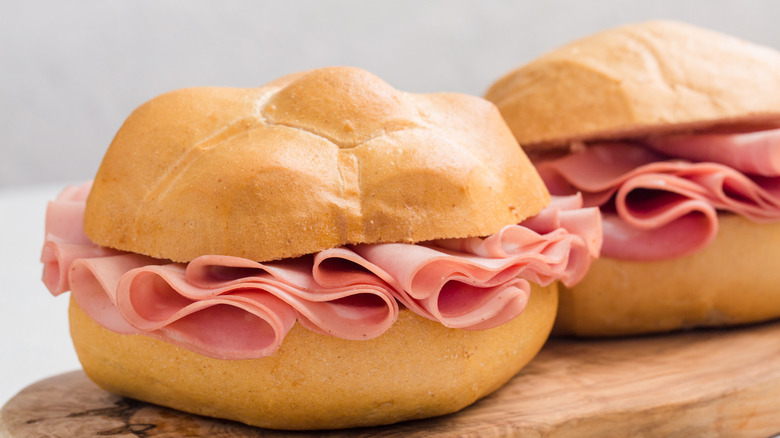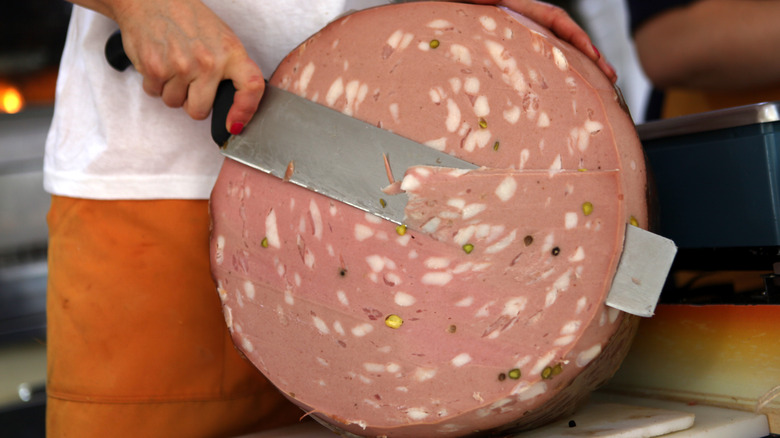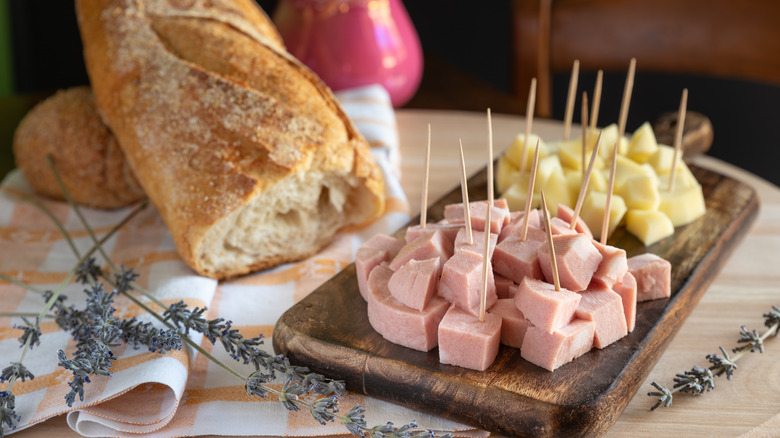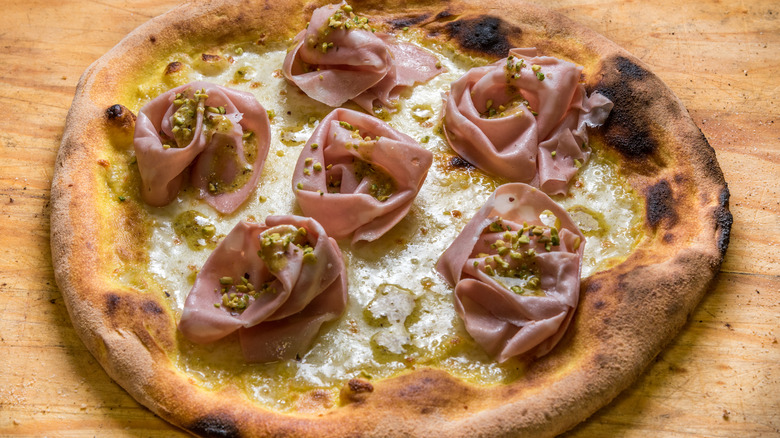The Real Difference Between Mortadella And Bologna
One you learned how to spell thanks to an iconic 1974 Oscar Mayer commercial. The other, you have tried on an Italian charcuterie board or in a giardiniera-spiked muffuletta sandwich. We're talking about bologna and mortadella, the silky, light pink pork sausages that have origins in Italy but very different stories since their conception. Here's how to tell the difference between two of the world's favorite lunch meats.
It's easy to distinguish between mortadella and bologna when you slice into the sausages. The first is given away by its white spots of pork fat, which stud each large link along with black peppercorns and, sometimes, green pistachios. Bologna, on the other hand, is completely smooth, its meat and seasonings thoroughly ground into one cohesive mixture. While the two products share similar ingredients, mortadella has a more delicate flavor than its porky relative. You'll understand why when you learn how they are made.
How is mortadella made?
Mortadella is one of the most prized foods from Bologna, the capital city of the Emilia-Romagna region of Italy nicknamed "La Grassa" (The Fat) for its rich culinary delicacies (via The Local). Its production process has changed little over the last few centuries, according to Bologna 4 You. A variety of pork cuts is finely ground into a smooth, pink paste, seasoned with ingredients like black pepper and anise, gently mixed with diced fat from a pig's neck, stuffed into large casings, and slowly baked. The pieces of fat distribute a melty, luxurious texture in each bite of mortadella.
Mortadella represents at least a 500-year-old tradition for the Bolognese, but it may have ancient Roman roots, according to Life in Italy. Its name likely derives from an old Roman sausage called farcimen mirtatum, which was flavored with myrtle ("mirtatum" in Latin) berries and ground with a mortar ("mortario") and pestle. Machines have expedited the process in modern times, and today, Italy produces more than 3 billion pounds of mortadella a year (via Food Insider).
Bologna was inspired by mortadella
Like mortadella, bologna is a sausage made with meat, fat, salt, and many of the same spices, such as coriander, black pepper, and myrtle berries. Bologna, however, can contain beef or other meats in addition to pork, while real mortadella can only contain pork, as stipulated by Cardinal Girolamo Farnese's 1661 law written to protect the sausage's traditional production process (via Bologna 4 You). USDA regulations require that the ingredients in bologna are comminuted, or completely emulsified into one homogenous mixture, according to HuffPost. That's why you cannot see any pieces of fat or pepper in your slice of Oscar Mayer.
As for its name, the spelling of bologna makes it clear that the lunchmeat derives from the Italian product, which was likely brought to the United States by German immigrants, says Eater. The pronunciation "baloney" may follow "the pattern of Italian words ending in -ia, like Italia, Sicilia, and Lombardia, which took on -y endings in English, like Italy, Sicily, and Lombardy," a linguist told HuffPost. Despite its origin (and inspiration), American bologna does not have the same porky richness or velvety texture as Italian mortadella.
Which is healthier — bologna or mortadella?
Bologna and mortadella are not particularly healthy for you, as is the case with any fatty meat product. It is, however, a little bit easier to know what you're putting in your body when you buy mortadella. Packaged bologna often has a vague ingredients list that doesn't always specify which animal parts or spices are used in the mixture, notes HuffPost.
Alternatively, you can be more discerning when buying mortadella, as looking out for the name Mortadella di Bologna IGP ensures your product was made in Emilia-Romagna and meets the government's production standards at the deli. Regional variations contain different ingredients, such as the smoked Mortadella di Amatrice with cloves and cinnamon or the Alchermes-spiked Mortadella di Prato, but are also heavily regulated and don't contain fillers or preservatives (via Life in Italy). Despite its visible fat chunks, mortadella actually contains mostly unsaturated fats and has about the same cholesterol content as a serving of chicken, says Bologna 4 You.
How to eat mortadella and bologna
Italians often snack on mortadella that has been thinly sliced or cut into cubes and eaten with some type of bread. You may also find it wrapped around grissini (bread sticks), stuffed into pizza bianca (Roman focaccia), or served with warm, English-muffin-like flatbreads called tigelle. It's also common to purée mortadella with other cold cuts or cheeses to be used as a stuffing for tortellini and ravioli or a spread for crostini.
Your parents might tell you that the best way to eat bologna is the way they probably did at school lunch in the 1970s: On white Wonder Bread with yellow mustard and American cheese — the ultimate processed American meal. You could chef up the nostalgic dish with this Bon Appétit recipe, that calls for frying thick-cut bologna in a cast-iron skillet, toasting your favorite bread in the leftover fat, and adding spicy brown mustard and dill pickles. And if anyone judges you for eating mystery meat, you can simply tell them that their opinions are a bunch of baloney!




